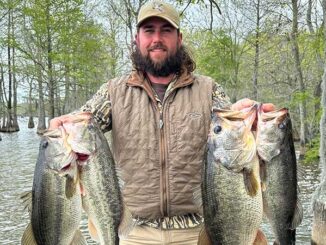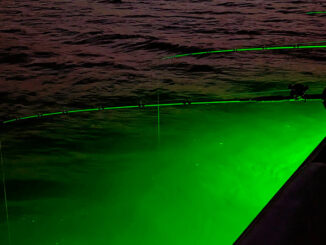
Santee Cooper’s blue catfish
The South Carolina Outdoor Press Association held its annual meeting at the Santee Cooper lakes in October. The meeting was packed with great fishing opportunities. And fisheries biologists also shared some comprehensive biological background information on the Santee Cooper fisheries.
The status of the blue catfish, specifically management plans for the species, drew high interest. Levi Kaczka, a regional fisheries biologist for the S.C. Department of Natural Resources, provided an excellent synopsis of how this extremely popular species evolved from its arrival origin to the current crossroads of future management decisions.
We Got the Blues
This world-class fishery began when the SCDNR worked with its counterparts in Arkansas. South Carolina traded some of our striped bass for some of their blue catfish. In December 1964, biologists stocked 30 sub-adult blues in the Santee Cooper lakes. They added an additional 150 sub-adults in April 1965.
These small stockings morphed into a strong fishery by the 1980s. Angler interest in catfishing increased. The catfish population exploded, with a quantum leap in the 1990s.
Boom goes Bust
SCDNR began tracking catfish with gill-net surveys in the 1980s. The agency documented a tremendous surge in the population through the 1990s and until 2001. The lakes became a national destination for blue catfish fishing. And the catfish action filled a void left by a striper fishery that was, at the time, sagging.
Fishing camps, guides and local businesses flourished during the catfish boom. And catfish became relevant to regional economy.
Then the bottom dropped out of the fishery. According to SCDNR sampling data, the population spiraled down from a peak in 2001 to a historic low in 2013. But as overall numbers dropped, anglers caught larger catfish. SCDNR proposed to the state legislature a first-of-its-kind catfish law in 2007 to protect these bigger fish. The law stipulated that anglers could keep only one catfish over 36 inches per day.
Another factor in fewer catfish was the timing of a normal biological pattern.
“The 1990s was the boom phase typically associated with a rapidly expanding fish species,” Kaczka said. “The population expansion required balance with forage and other factors. And that balance is typically lower than the all-time high. Plus, several consecutive dry years in the late 1990s likely corresponded to poor spawning success of blue catfish.”
Kaczka said, based on the data, that nothing dramatic changed biologically in terms of forage or water quality over the next few years. But rod-and-reel anglers and commercial fishermen put year-round pressure on the resource.
Future prognosis
South Carolina does not recognize the blue catfish as a gamefish. But it is recognized as a highly valuable resource. The 2007 regulation was not maintaining the fishery as hoped.
Kaczka said the goal was to produce a blend of good numbers of fish, while maintaining the opportunity to hook trophy catfish. In 2014, SCDNR presented another recommendation. Lawmakers passed the 2014 blue catfish law.
“The law sought a balance, by limiting the creel to only two fish kept over 32 inches to spread out the harvest of trophy catfish among Santee Cooper’s anglers,” Kaczka said. “An overall creel of 25 blue catfish was established. This enables anglers to keep plenty of fish for consumption while providing protection for the overall resources.”
The good news is that the 2014 law worked, and SCDNR sampling data revealed more quality and quantity of catfish in the system. Many rod-and-reel anglers went a step further by implementing “CPR” (catch, photograph and release) for big fish. They began voluntarily keeping only smaller fish for consumption.
What happens now?
But the bad news was a “sunset clause” added to the 2014 law by the legislature. This clause stipulated the law would expire in 2018, reverting back to the 2007 law, if not passed again in 2018. That’s what occurred.
The point for sportsmen now is not to debate why something occurred, but to focus on getting it fixed.
Kaczka said the wording of the 2014 blue catfish law was reintroduced to the legislature this year. But the bill stalled in committee. Fortunately, it’s a two-year process, and the proposal will be open for consideration when the legislature convenes next month.
Biological data supporting this law as good is very strong. Plus, the practical experience of every catfish guide and serious Santee Cooper angler I’ve spoken with in the past year supports the 2014 law as having a profound, positive impact during the years it existed.
If the legislature passes a new version of the 2014 law, the hope of continuing and expanding the renewed catfishing success exists. If not, we’ll need a new plan, and the politics will consume crucial time that this remarkable fishery needs for recovery, especially when a good plan sits on the table.
The fate of this valuable resource is now in the hands of our lawmakers. Let them know how you feel.





Be the first to comment